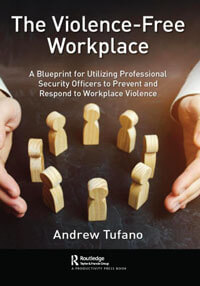Book Review: The Violence-Free Workplace: A Blueprint for Utilizing Professional Security Officers to Prevent and Respond to Workplace Violence
By Andrew Tufano. Routledge; 278 pages; $49.95
 The Violence-Free Workplace is an extraordinary study of what a professional security organization should look like. The author is brutally honest in analyzing the most common issues facing security organizations, from the way the industry is treated by law enforcement to the challenges it faces from its own corporate managers. The result is a thought-provoking collection of recommendations that should be reviewed and considered, even if the reader does not agree with them.
The Violence-Free Workplace is an extraordinary study of what a professional security organization should look like. The author is brutally honest in analyzing the most common issues facing security organizations, from the way the industry is treated by law enforcement to the challenges it faces from its own corporate managers. The result is a thought-provoking collection of recommendations that should be reviewed and considered, even if the reader does not agree with them.
The book is well laid out and has easy to follow chapters led by a problem statement and closed out by clear-cut recommendations, plus summaries. There are numerous examples—either real or hypothetical—in every chapter that help to drive home concepts and explanations.
The book drives discussion and evaluation of the security industry. In the chapter on health and fitness standards, the author compares the discrepancy in fitness standards between security officers and lifeguards, before explaining that both positions require extended periods of stationary duty interrupted with occasional but serious high-stress activity. It becomes a fitting exclamation point to a chapter already laden with statistics on obesity by industry.
Another discussion centers on the typical use of security as either observe-and-report or forced compliance. The author delivers a compelling argument for the inadequacy of both models, considering both the need to intervene in critical incidents and the need to build and maintain positive relationships.
The discussion on key differences between law enforcement and security throughout the book is exceptional as well. The author reminds readers that when law enforcement departs after an incident, the security officer is still left at the scene dealing with long-term residual resentment from employees and friends of the person they helped remove.
Overall, this is a great book with a wealth of relevant information that would benefit not only security professionals, but also those in law enforcement who may one day work with or for a security organization. It should be shared with C-suite senior managers who may oversee their organization’s security teams within their busy portfolios.
Reviewer: Yan Byalik, CPP, is the security administrator for the City of Newport News, Virginia, where he manages a team tasked with protecting the city’s critical infrastructure and serves on numerous city multidisciplinary working groups providing security input on major initiatives such as mass vaccinations, election security, and special events.